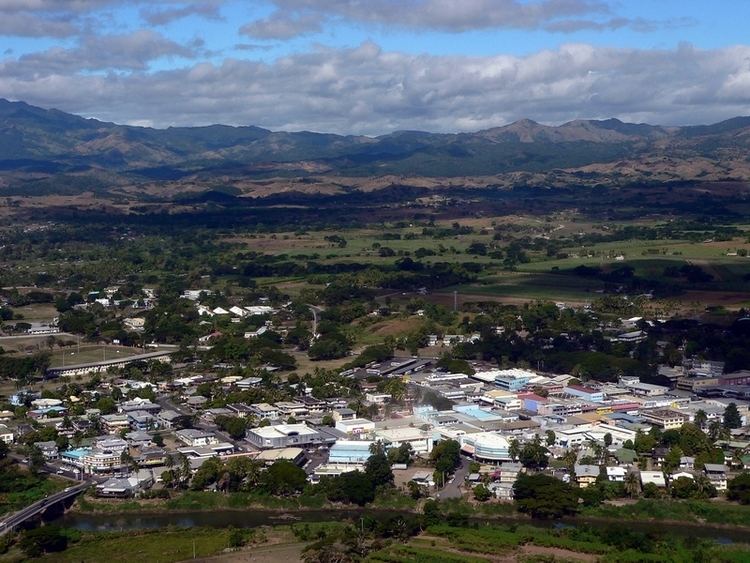Local time Monday 10:13 AM | Population 42,284 (2007) | |
 | ||
Weather 30°C, Wind E at 18 km/h, 59% Humidity Points of interest Denarau Island, Mamanuca Islands, Kula Eco Park, Sri Siva Subramaniya temple, Nananu‑i‑Ra | ||
Hd tour of nadi fiji and surrounding area fiji tropical paradise island
Nadi (pronounced [ˈnandi]) is the third-largest conurbation in Fiji. It is located on the western side of the main island of Viti Levu, and had a population of 42,284 at the most recent census, in 2007. A 2012 estimate showed that the population had grown to over 50,000. Nadi is multiracial with many of its inhabitants Indian or Fijian, along with a large transient population of foreign tourists. Along with sugar cane production, tourism is a mainstay of the local economy.
Contents
- Hd tour of nadi fiji and surrounding area fiji tropical paradise island
- Map of Nadi Fiji
- Knowing fiji in 5 minutes travel cultural yasawa island nadi blue lagoon
- History
- Government and infrastructure
- Economy
- Local Government
- Housing
- References
Map of Nadi, Fiji
The Nadi region has a higher concentration of hotels and motels than any other part of Fiji. With its large Indo-Fijian population, Nadi is a centre for Hinduism and Islam in Fiji. It has the largest Hindu temple in the Southern hemisphere, and is a site for pilgrims called Sri Siva Subramaniya temple. Muslims worship at the Nadi Mosque and the Ahmadiyyahs worship at the Ahmadiya Mosque. Nadi International Airport located 9 kilometres from the town, is the largest airport in Fiji. Thus, Nadi is the principal port of entry for air travellers to Fiji, even though it is on the opposite (western) side of the island of Viti Levu from the nation's capital and largest city, Suva.
Knowing fiji in 5 minutes travel cultural yasawa island nadi blue lagoon
History
Nadi Township was established in 1947. Around that time the colonial government of Fiji established offices on the higher grounds of Nadi. A few businesses were then established around the government offices to service them, and other business organisations from other parts of Fiji followed suit. Some concerned citizens of Nadi attempted to move the town centre to Martintar because the existing centre was prone to flooding, but this did not eventuate because the move Nadi Township had already developed strong roots in its existing location.
Elective local government was introduced in 1967. Dr A. H. Sahu Khan was the first elected Chairman of the Nadi Township Board. With the introduction of the Local Government Act in 1972, the status of the Board was changed to a Town Council. H. M. Lodhia became the first Mayor of Nadi in 1972 and remained in office until December 1973. The most recent Mayor of Nadi was Councillor S. Sami. At present, elected municipal government in Nadi (and also throughout Fiji) is suspended, and government-appointed Administrators are carrying out the functions normally fulfilled by the City Council.
Government and infrastructure
The Civil Aviation Authority of Fiji (CAAFI) head office is at Nadi Airport in Nadi.
Economy
Fiji Airways, formerly Air Pacific has its head office at the Air Pacific Maintenance & Administration Centre at Nadi International Airport in Nadi. Fiji Airlines Limited, operating as Pacific Sun, is headquartered in the Pacific Sun building in the Civil Aviation Authority of Fiji (CAAFI) compound at Nadi International Airport.
Nadi’s economy is driven by the tourism, transportation and real estate sectors. Within these formal industries, the informal sector plays a relative small role, mainly consisting of tourism and agricultural businesses, including handicrafts.
Local Government
Nadi Town is governed by the Nadi Town Council (NTC). The council is headed by a Special Administrator, appointed by the central government, and managed by a Chief Executive Officer (CEO). Both posts answer to the Ministry of Local Government, Urban Development, Housing and Environment. The performance of the Special Administrator is evaluated often, and the position has clear objectives such as improving rates collection and shifting from cash to accrual accounting in council operations. Nevertheless, overlap between the CEO and the Special Administrator posts is leading to confusion, resulting in high staff turnover – there have been three CEOs appointed since 2008.
Housing
Housing development in Nadi largely takes the form of either medium-density complexes or lower-density social housing. Of this latter, the Housing Authority is actively seeking to increase the supply of affordable housing. The number of housing estates in Nadi has grown quickly, especially on the town periphery, such that housing estates now comprise 20 per cent of the total housing stock in Nadi.
